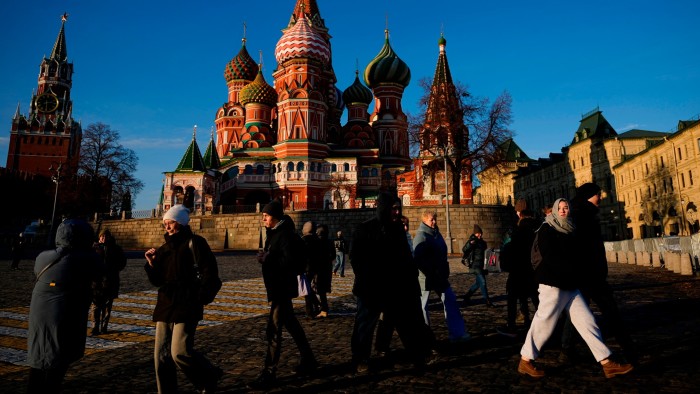Unlock the White House Watch newsletter for free
Your guide to what the 2024 US election means for Washington and the world
Russia’s rouble has plummeted to its lowest rate against the dollar since the first weeks of its full-scale invasion of Ukraine, as the currency felt the bite of new US sanctions against Gazprombank.
On Tuesday, the rouble hit 107 against the dollar for the first time since March 2022. At Rbs14, the rouble was also at its lowest level against the renminbi for 32 months.
The US last week placed sanctions on Russian banks that had become widely used for international payments, keeping foreign trade flowing. Gazprombank played a critical role administering most payments for the gas Russia sells abroad. Losing this channel raises the prospect of a decrease in gas revenues.
Making international payments is already a huge challenge for Russian businesses and one of the biggest constraints on the economy, according to the central bank. With the new sanctions shutting down more avenues for such transactions, Russia’s trade balance is expected to worsen, pushing the rouble down further.
“Now foreign buyers of Russian gas and oil . . . need to find alternative payment methods,” said Alexander Potavin, analyst at FG Finam. “New routes for sending money will be found for this purpose, for example through accounts in other banks or using other world currencies. But this takes time.”
He added that the rouble’s depreciation “will reflect the shortage of currency”.
After two months of depreciation, the rouble’s sharper fall on Tuesday took it far beyond the “100 for a dollar” rate that was long considered a psychological red line for Russians.
But where such a level was once a shock, it is now seen as the new normal.
Analysts also pointed to a decrease in conversion of foreign currency export proceeds — after rules that were introduced to prevent a collapse of the economy in 2022 were relaxed earlier this year — leading to fewer exchanges to support the rouble.
As Russia’s winter holiday season approaches, “businesses usually have a need for imports, and there is a seasonal demand for currency”, Potavin said. “A year earlier this need was closed quite quickly by increasing the rate of sale of foreign currency earnings from exporters, [but] this year the authorities do not want to do this.”
With the budget deficit growing as Russia boosts military spending, a weaker rouble may suit President Vladimir Putin’s government. Russia receives about half of its budget revenues in foreign currency, mostly through oil and gas exports, while spending is mostly in roubles.
“They need a weaker rouble to fill the state budget because of huge defence spending,” Potavin said. “Experts estimate that a change in the dollar exchange rate by just Rbs1 could increase annual oil and gas budget revenues by about Rbs100bn.”
Finance minister Anton Siluanov on Tuesday indicated that the government was not trying to prop up the rouble.
“I’m not saying whether the rate is good or bad. I’m just saying that today the exchange rate . . . is very, very conducive to exports,” Siluanov was quoted by state news agencies as saying at a forum.
Some economists argue that the weak rouble leads to stubbornly higher inflation that Moscow is desperate to curb.
Data visualisation by Ray Douglas
https://www.ft.com/content/6189fdb4-d1ef-4e0b-a7f1-e7f9a7286df5


